Conflict and Development: Correlation between Refugees, Migration and Role in Conflict
VerifiedAdded on 2023/06/11
|15
|3474
|257
AI Summary
This essay explores the correlation between refugees, migration and their role in conflict. It discusses the impact of conflict on the economy and societal implications of a state.
Contribute Materials
Your contribution can guide someone’s learning journey. Share your
documents today.
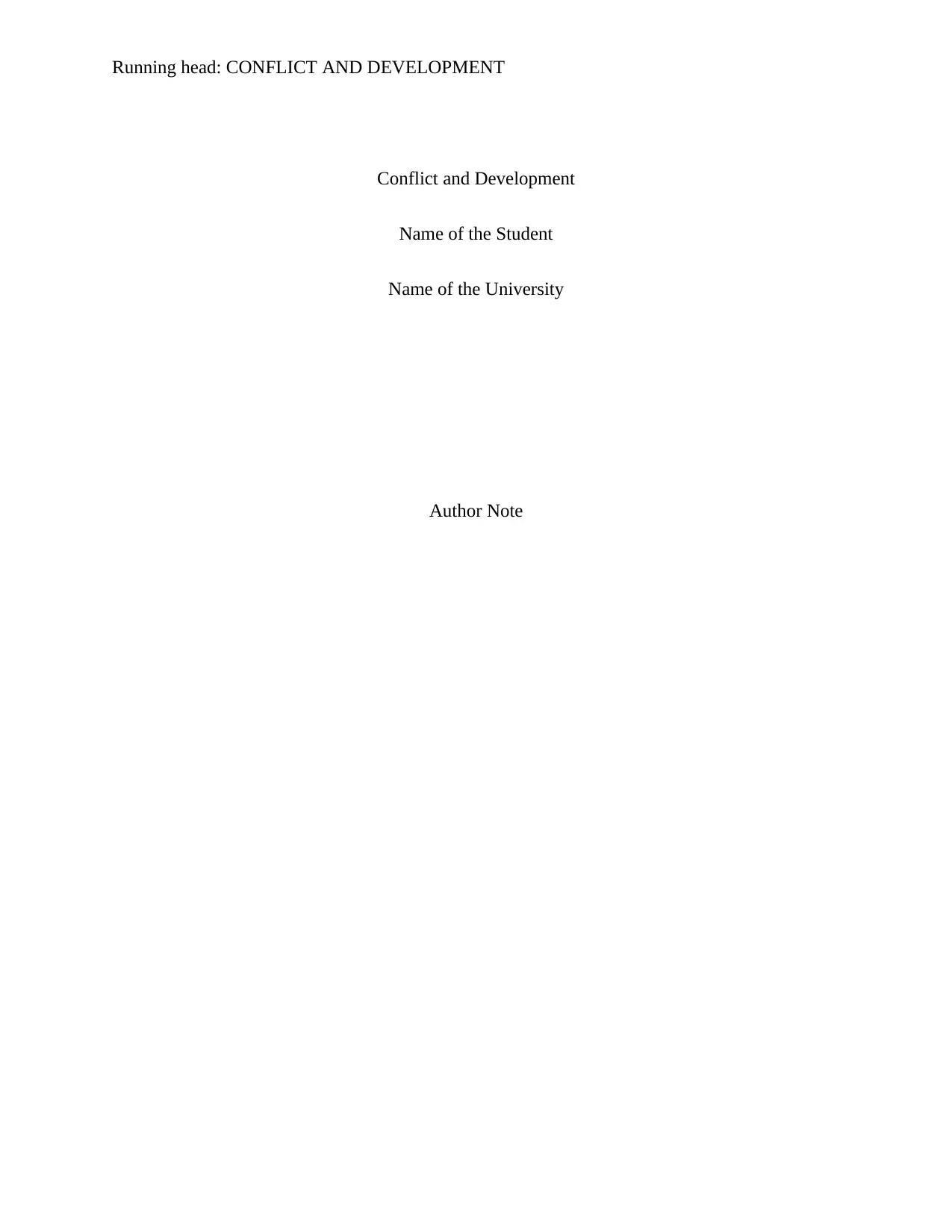
Running head: CONFLICT AND DEVELOPMENT
Conflict and Development
Name of the Student
Name of the University
Author Note
Conflict and Development
Name of the Student
Name of the University
Author Note
Secure Best Marks with AI Grader
Need help grading? Try our AI Grader for instant feedback on your assignments.
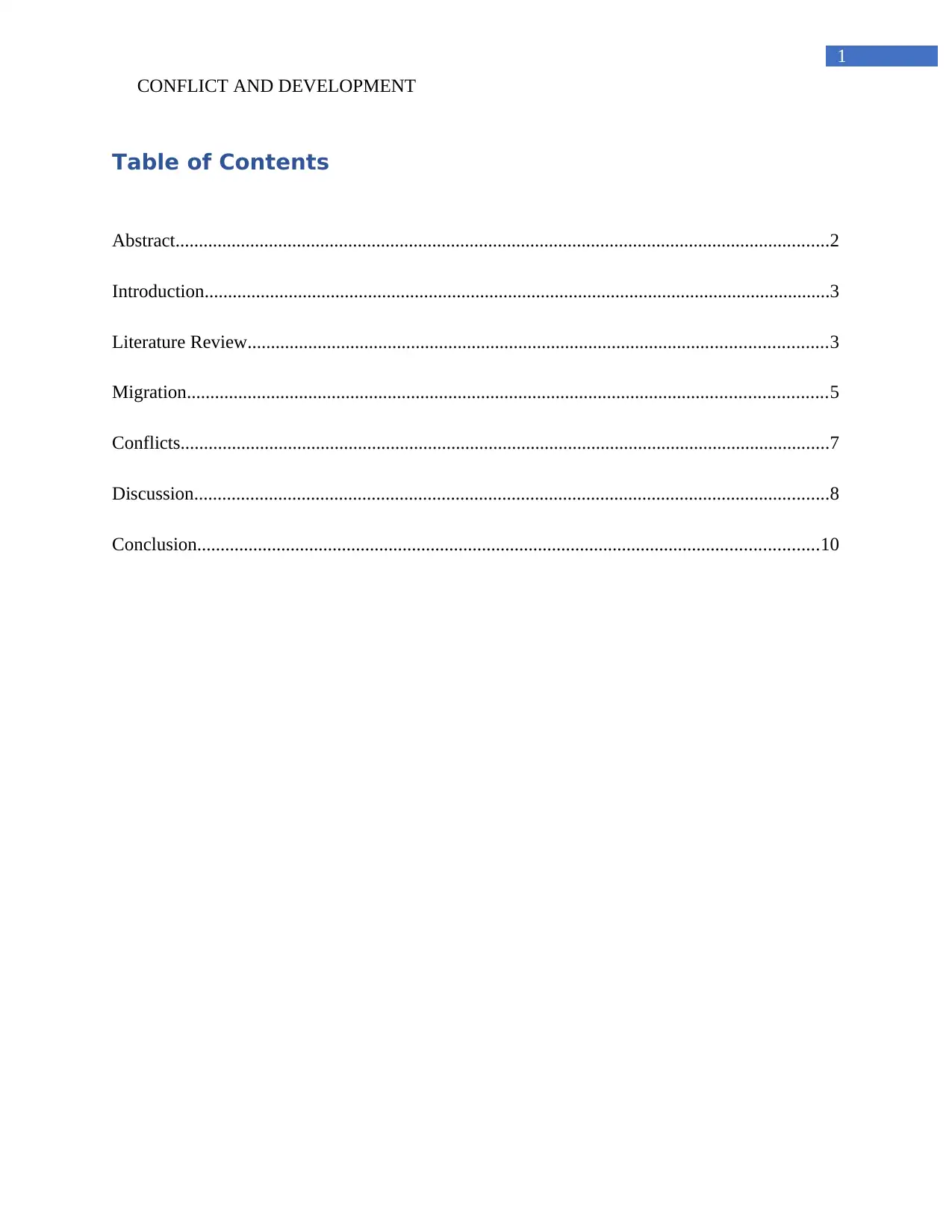
1
CONFLICT AND DEVELOPMENT
Table of Contents
Abstract............................................................................................................................................2
Introduction......................................................................................................................................3
Literature Review............................................................................................................................3
Migration.........................................................................................................................................5
Conflicts...........................................................................................................................................7
Discussion........................................................................................................................................8
Conclusion.....................................................................................................................................10
CONFLICT AND DEVELOPMENT
Table of Contents
Abstract............................................................................................................................................2
Introduction......................................................................................................................................3
Literature Review............................................................................................................................3
Migration.........................................................................................................................................5
Conflicts...........................................................................................................................................7
Discussion........................................................................................................................................8
Conclusion.....................................................................................................................................10
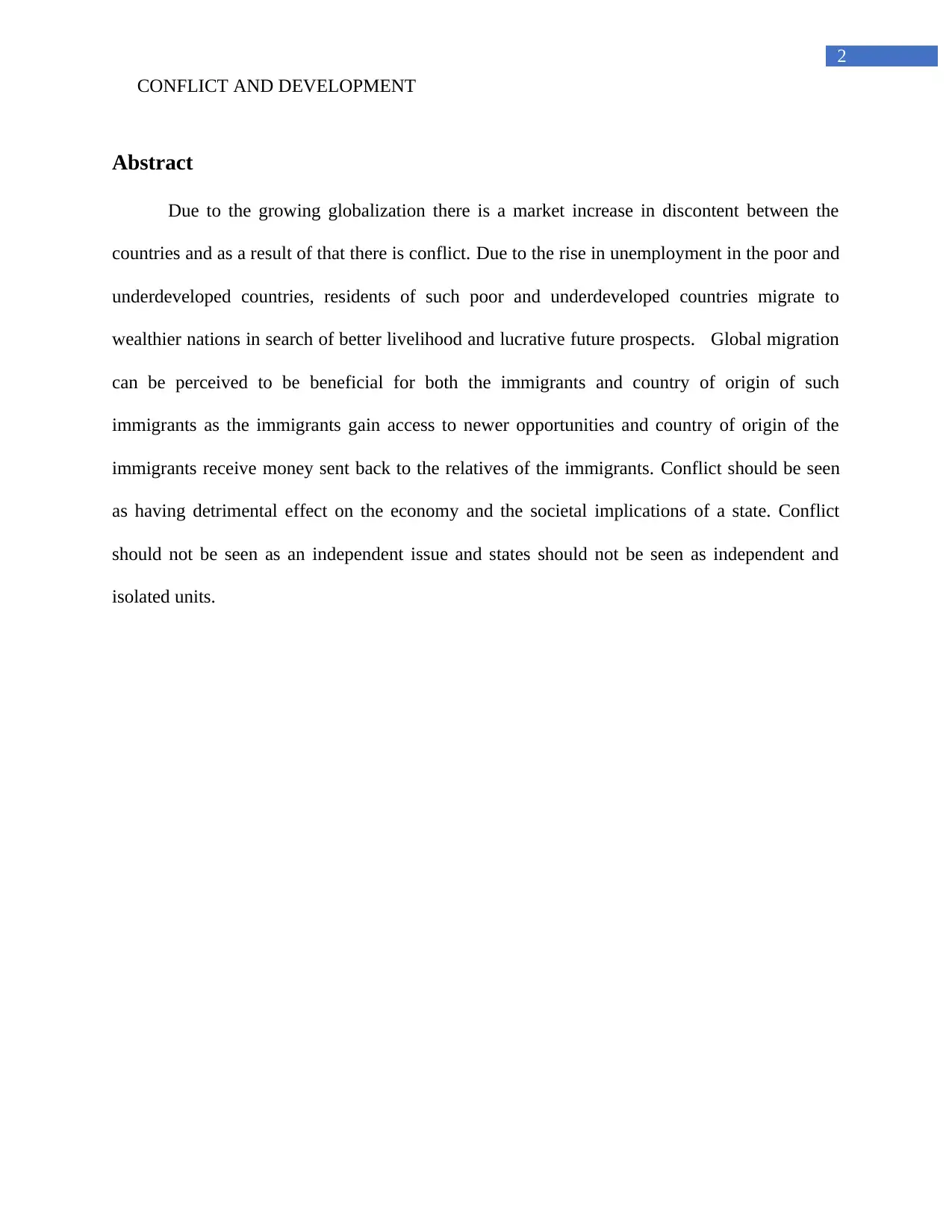
2
CONFLICT AND DEVELOPMENT
Abstract
Due to the growing globalization there is a market increase in discontent between the
countries and as a result of that there is conflict. Due to the rise in unemployment in the poor and
underdeveloped countries, residents of such poor and underdeveloped countries migrate to
wealthier nations in search of better livelihood and lucrative future prospects. Global migration
can be perceived to be beneficial for both the immigrants and country of origin of such
immigrants as the immigrants gain access to newer opportunities and country of origin of the
immigrants receive money sent back to the relatives of the immigrants. Conflict should be seen
as having detrimental effect on the economy and the societal implications of a state. Conflict
should not be seen as an independent issue and states should not be seen as independent and
isolated units.
CONFLICT AND DEVELOPMENT
Abstract
Due to the growing globalization there is a market increase in discontent between the
countries and as a result of that there is conflict. Due to the rise in unemployment in the poor and
underdeveloped countries, residents of such poor and underdeveloped countries migrate to
wealthier nations in search of better livelihood and lucrative future prospects. Global migration
can be perceived to be beneficial for both the immigrants and country of origin of such
immigrants as the immigrants gain access to newer opportunities and country of origin of the
immigrants receive money sent back to the relatives of the immigrants. Conflict should be seen
as having detrimental effect on the economy and the societal implications of a state. Conflict
should not be seen as an independent issue and states should not be seen as independent and
isolated units.
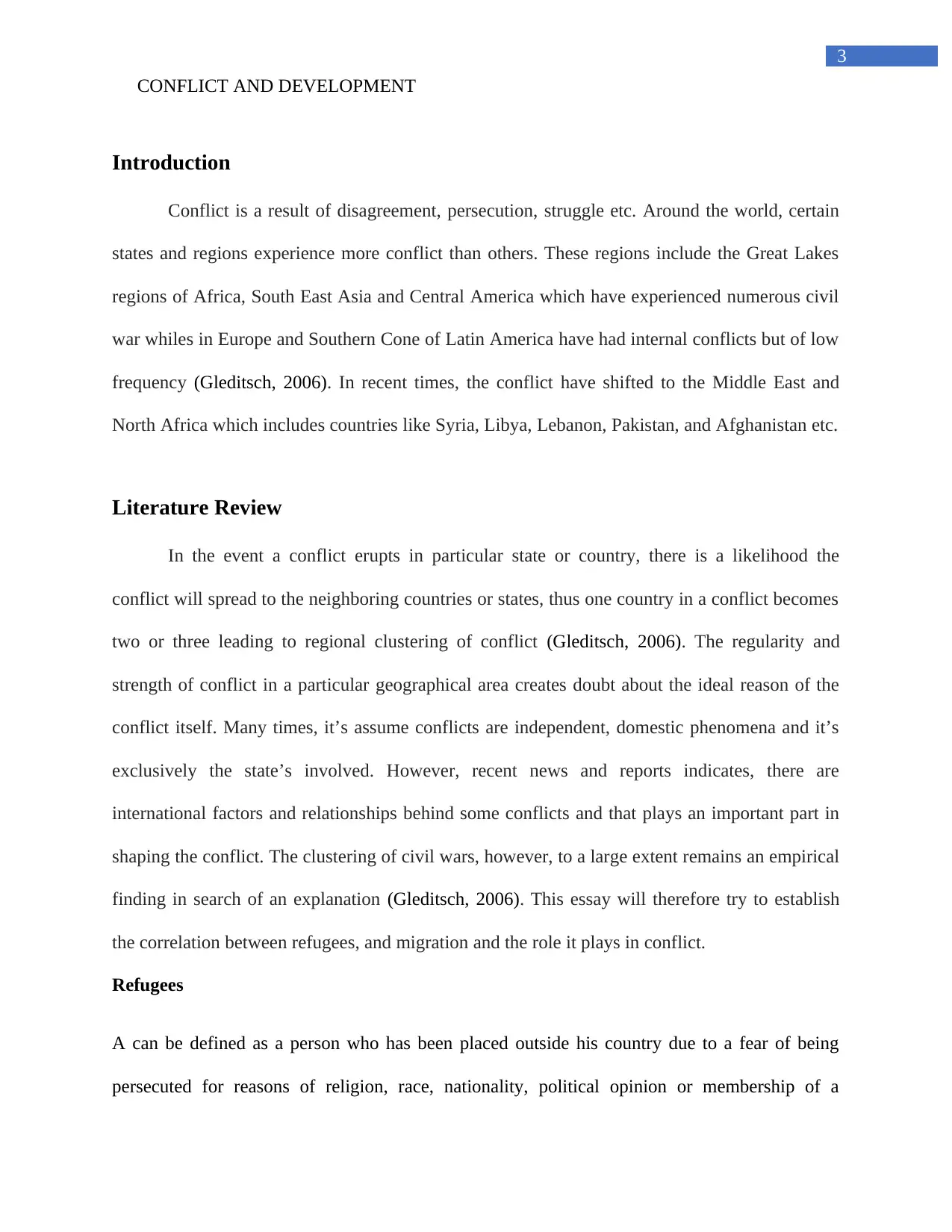
3
CONFLICT AND DEVELOPMENT
Introduction
Conflict is a result of disagreement, persecution, struggle etc. Around the world, certain
states and regions experience more conflict than others. These regions include the Great Lakes
regions of Africa, South East Asia and Central America which have experienced numerous civil
war whiles in Europe and Southern Cone of Latin America have had internal conflicts but of low
frequency (Gleditsch, 2006). In recent times, the conflict have shifted to the Middle East and
North Africa which includes countries like Syria, Libya, Lebanon, Pakistan, and Afghanistan etc.
Literature Review
In the event a conflict erupts in particular state or country, there is a likelihood the
conflict will spread to the neighboring countries or states, thus one country in a conflict becomes
two or three leading to regional clustering of conflict (Gleditsch, 2006). The regularity and
strength of conflict in a particular geographical area creates doubt about the ideal reason of the
conflict itself. Many times, it’s assume conflicts are independent, domestic phenomena and it’s
exclusively the state’s involved. However, recent news and reports indicates, there are
international factors and relationships behind some conflicts and that plays an important part in
shaping the conflict. The clustering of civil wars, however, to a large extent remains an empirical
finding in search of an explanation (Gleditsch, 2006). This essay will therefore try to establish
the correlation between refugees, and migration and the role it plays in conflict.
Refugees
A can be defined as a person who has been placed outside his country due to a fear of being
persecuted for reasons of religion, race, nationality, political opinion or membership of a
CONFLICT AND DEVELOPMENT
Introduction
Conflict is a result of disagreement, persecution, struggle etc. Around the world, certain
states and regions experience more conflict than others. These regions include the Great Lakes
regions of Africa, South East Asia and Central America which have experienced numerous civil
war whiles in Europe and Southern Cone of Latin America have had internal conflicts but of low
frequency (Gleditsch, 2006). In recent times, the conflict have shifted to the Middle East and
North Africa which includes countries like Syria, Libya, Lebanon, Pakistan, and Afghanistan etc.
Literature Review
In the event a conflict erupts in particular state or country, there is a likelihood the
conflict will spread to the neighboring countries or states, thus one country in a conflict becomes
two or three leading to regional clustering of conflict (Gleditsch, 2006). The regularity and
strength of conflict in a particular geographical area creates doubt about the ideal reason of the
conflict itself. Many times, it’s assume conflicts are independent, domestic phenomena and it’s
exclusively the state’s involved. However, recent news and reports indicates, there are
international factors and relationships behind some conflicts and that plays an important part in
shaping the conflict. The clustering of civil wars, however, to a large extent remains an empirical
finding in search of an explanation (Gleditsch, 2006). This essay will therefore try to establish
the correlation between refugees, and migration and the role it plays in conflict.
Refugees
A can be defined as a person who has been placed outside his country due to a fear of being
persecuted for reasons of religion, race, nationality, political opinion or membership of a
Secure Best Marks with AI Grader
Need help grading? Try our AI Grader for instant feedback on your assignments.
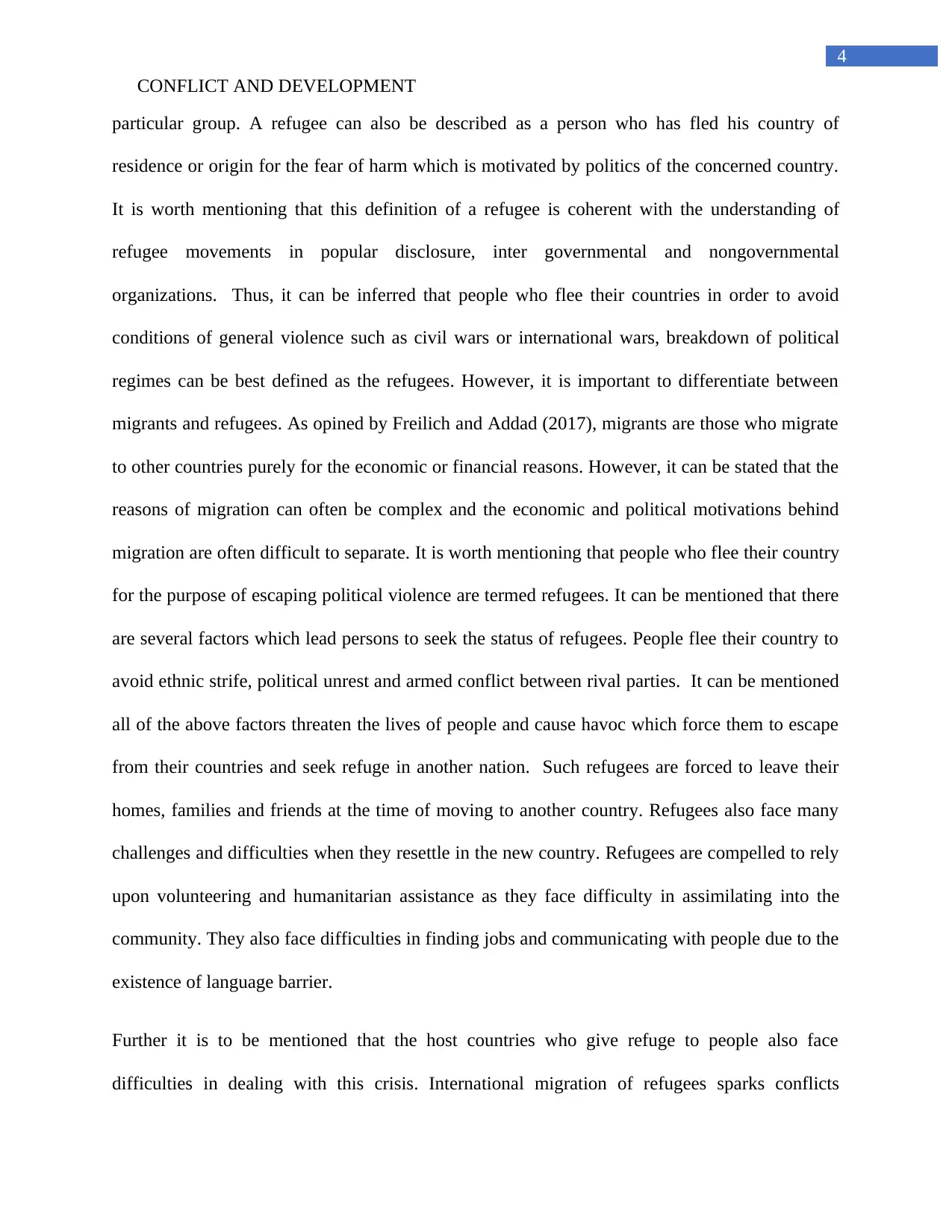
4
CONFLICT AND DEVELOPMENT
particular group. A refugee can also be described as a person who has fled his country of
residence or origin for the fear of harm which is motivated by politics of the concerned country.
It is worth mentioning that this definition of a refugee is coherent with the understanding of
refugee movements in popular disclosure, inter governmental and nongovernmental
organizations. Thus, it can be inferred that people who flee their countries in order to avoid
conditions of general violence such as civil wars or international wars, breakdown of political
regimes can be best defined as the refugees. However, it is important to differentiate between
migrants and refugees. As opined by Freilich and Addad (2017), migrants are those who migrate
to other countries purely for the economic or financial reasons. However, it can be stated that the
reasons of migration can often be complex and the economic and political motivations behind
migration are often difficult to separate. It is worth mentioning that people who flee their country
for the purpose of escaping political violence are termed refugees. It can be mentioned that there
are several factors which lead persons to seek the status of refugees. People flee their country to
avoid ethnic strife, political unrest and armed conflict between rival parties. It can be mentioned
all of the above factors threaten the lives of people and cause havoc which force them to escape
from their countries and seek refuge in another nation. Such refugees are forced to leave their
homes, families and friends at the time of moving to another country. Refugees also face many
challenges and difficulties when they resettle in the new country. Refugees are compelled to rely
upon volunteering and humanitarian assistance as they face difficulty in assimilating into the
community. They also face difficulties in finding jobs and communicating with people due to the
existence of language barrier.
Further it is to be mentioned that the host countries who give refuge to people also face
difficulties in dealing with this crisis. International migration of refugees sparks conflicts
CONFLICT AND DEVELOPMENT
particular group. A refugee can also be described as a person who has fled his country of
residence or origin for the fear of harm which is motivated by politics of the concerned country.
It is worth mentioning that this definition of a refugee is coherent with the understanding of
refugee movements in popular disclosure, inter governmental and nongovernmental
organizations. Thus, it can be inferred that people who flee their countries in order to avoid
conditions of general violence such as civil wars or international wars, breakdown of political
regimes can be best defined as the refugees. However, it is important to differentiate between
migrants and refugees. As opined by Freilich and Addad (2017), migrants are those who migrate
to other countries purely for the economic or financial reasons. However, it can be stated that the
reasons of migration can often be complex and the economic and political motivations behind
migration are often difficult to separate. It is worth mentioning that people who flee their country
for the purpose of escaping political violence are termed refugees. It can be mentioned that there
are several factors which lead persons to seek the status of refugees. People flee their country to
avoid ethnic strife, political unrest and armed conflict between rival parties. It can be mentioned
all of the above factors threaten the lives of people and cause havoc which force them to escape
from their countries and seek refuge in another nation. Such refugees are forced to leave their
homes, families and friends at the time of moving to another country. Refugees also face many
challenges and difficulties when they resettle in the new country. Refugees are compelled to rely
upon volunteering and humanitarian assistance as they face difficulty in assimilating into the
community. They also face difficulties in finding jobs and communicating with people due to the
existence of language barrier.
Further it is to be mentioned that the host countries who give refuge to people also face
difficulties in dealing with this crisis. International migration of refugees sparks conflicts
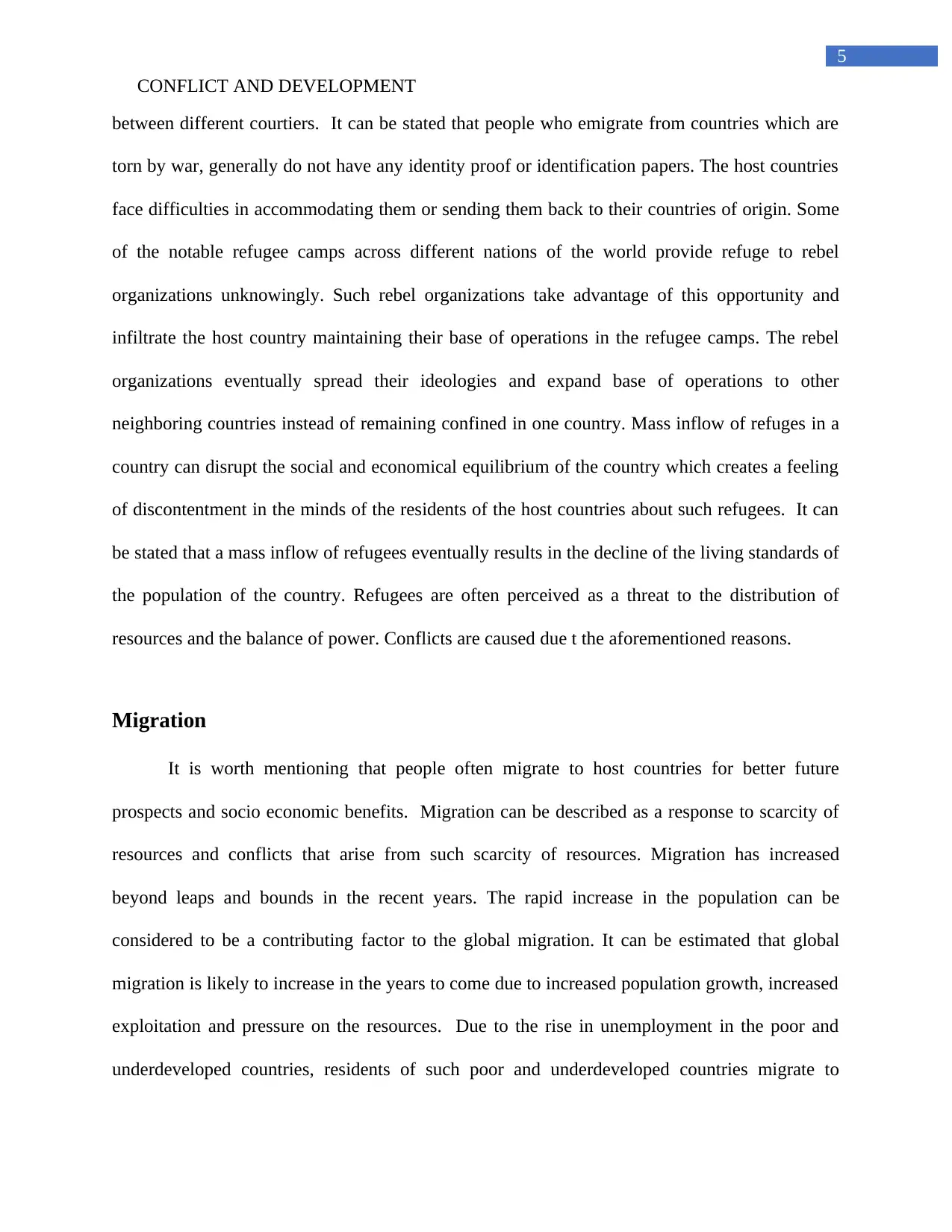
5
CONFLICT AND DEVELOPMENT
between different courtiers. It can be stated that people who emigrate from countries which are
torn by war, generally do not have any identity proof or identification papers. The host countries
face difficulties in accommodating them or sending them back to their countries of origin. Some
of the notable refugee camps across different nations of the world provide refuge to rebel
organizations unknowingly. Such rebel organizations take advantage of this opportunity and
infiltrate the host country maintaining their base of operations in the refugee camps. The rebel
organizations eventually spread their ideologies and expand base of operations to other
neighboring countries instead of remaining confined in one country. Mass inflow of refuges in a
country can disrupt the social and economical equilibrium of the country which creates a feeling
of discontentment in the minds of the residents of the host countries about such refugees. It can
be stated that a mass inflow of refugees eventually results in the decline of the living standards of
the population of the country. Refugees are often perceived as a threat to the distribution of
resources and the balance of power. Conflicts are caused due t the aforementioned reasons.
Migration
It is worth mentioning that people often migrate to host countries for better future
prospects and socio economic benefits. Migration can be described as a response to scarcity of
resources and conflicts that arise from such scarcity of resources. Migration has increased
beyond leaps and bounds in the recent years. The rapid increase in the population can be
considered to be a contributing factor to the global migration. It can be estimated that global
migration is likely to increase in the years to come due to increased population growth, increased
exploitation and pressure on the resources. Due to the rise in unemployment in the poor and
underdeveloped countries, residents of such poor and underdeveloped countries migrate to
CONFLICT AND DEVELOPMENT
between different courtiers. It can be stated that people who emigrate from countries which are
torn by war, generally do not have any identity proof or identification papers. The host countries
face difficulties in accommodating them or sending them back to their countries of origin. Some
of the notable refugee camps across different nations of the world provide refuge to rebel
organizations unknowingly. Such rebel organizations take advantage of this opportunity and
infiltrate the host country maintaining their base of operations in the refugee camps. The rebel
organizations eventually spread their ideologies and expand base of operations to other
neighboring countries instead of remaining confined in one country. Mass inflow of refuges in a
country can disrupt the social and economical equilibrium of the country which creates a feeling
of discontentment in the minds of the residents of the host countries about such refugees. It can
be stated that a mass inflow of refugees eventually results in the decline of the living standards of
the population of the country. Refugees are often perceived as a threat to the distribution of
resources and the balance of power. Conflicts are caused due t the aforementioned reasons.
Migration
It is worth mentioning that people often migrate to host countries for better future
prospects and socio economic benefits. Migration can be described as a response to scarcity of
resources and conflicts that arise from such scarcity of resources. Migration has increased
beyond leaps and bounds in the recent years. The rapid increase in the population can be
considered to be a contributing factor to the global migration. It can be estimated that global
migration is likely to increase in the years to come due to increased population growth, increased
exploitation and pressure on the resources. Due to the rise in unemployment in the poor and
underdeveloped countries, residents of such poor and underdeveloped countries migrate to
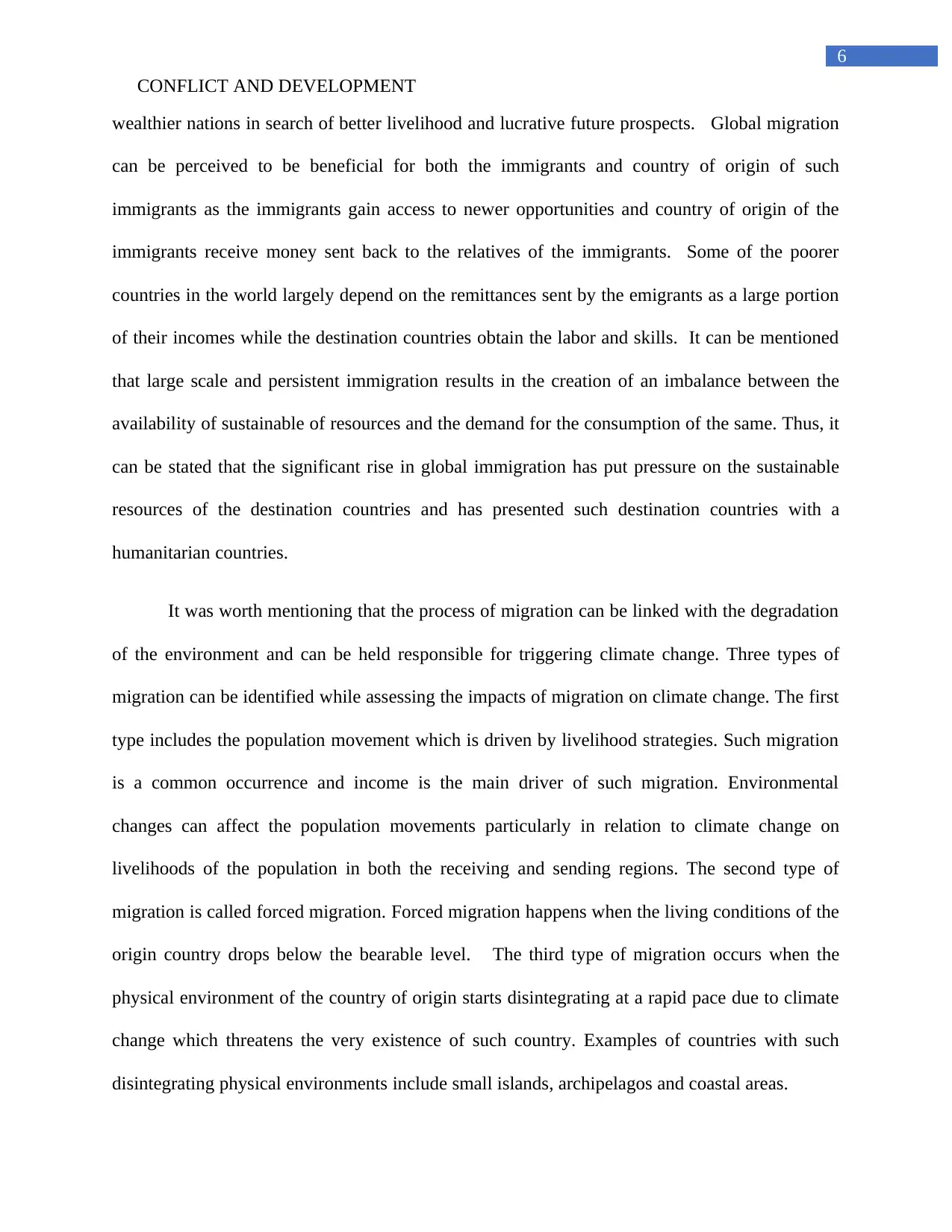
6
CONFLICT AND DEVELOPMENT
wealthier nations in search of better livelihood and lucrative future prospects. Global migration
can be perceived to be beneficial for both the immigrants and country of origin of such
immigrants as the immigrants gain access to newer opportunities and country of origin of the
immigrants receive money sent back to the relatives of the immigrants. Some of the poorer
countries in the world largely depend on the remittances sent by the emigrants as a large portion
of their incomes while the destination countries obtain the labor and skills. It can be mentioned
that large scale and persistent immigration results in the creation of an imbalance between the
availability of sustainable of resources and the demand for the consumption of the same. Thus, it
can be stated that the significant rise in global immigration has put pressure on the sustainable
resources of the destination countries and has presented such destination countries with a
humanitarian countries.
It was worth mentioning that the process of migration can be linked with the degradation
of the environment and can be held responsible for triggering climate change. Three types of
migration can be identified while assessing the impacts of migration on climate change. The first
type includes the population movement which is driven by livelihood strategies. Such migration
is a common occurrence and income is the main driver of such migration. Environmental
changes can affect the population movements particularly in relation to climate change on
livelihoods of the population in both the receiving and sending regions. The second type of
migration is called forced migration. Forced migration happens when the living conditions of the
origin country drops below the bearable level. The third type of migration occurs when the
physical environment of the country of origin starts disintegrating at a rapid pace due to climate
change which threatens the very existence of such country. Examples of countries with such
disintegrating physical environments include small islands, archipelagos and coastal areas.
CONFLICT AND DEVELOPMENT
wealthier nations in search of better livelihood and lucrative future prospects. Global migration
can be perceived to be beneficial for both the immigrants and country of origin of such
immigrants as the immigrants gain access to newer opportunities and country of origin of the
immigrants receive money sent back to the relatives of the immigrants. Some of the poorer
countries in the world largely depend on the remittances sent by the emigrants as a large portion
of their incomes while the destination countries obtain the labor and skills. It can be mentioned
that large scale and persistent immigration results in the creation of an imbalance between the
availability of sustainable of resources and the demand for the consumption of the same. Thus, it
can be stated that the significant rise in global immigration has put pressure on the sustainable
resources of the destination countries and has presented such destination countries with a
humanitarian countries.
It was worth mentioning that the process of migration can be linked with the degradation
of the environment and can be held responsible for triggering climate change. Three types of
migration can be identified while assessing the impacts of migration on climate change. The first
type includes the population movement which is driven by livelihood strategies. Such migration
is a common occurrence and income is the main driver of such migration. Environmental
changes can affect the population movements particularly in relation to climate change on
livelihoods of the population in both the receiving and sending regions. The second type of
migration is called forced migration. Forced migration happens when the living conditions of the
origin country drops below the bearable level. The third type of migration occurs when the
physical environment of the country of origin starts disintegrating at a rapid pace due to climate
change which threatens the very existence of such country. Examples of countries with such
disintegrating physical environments include small islands, archipelagos and coastal areas.
Paraphrase This Document
Need a fresh take? Get an instant paraphrase of this document with our AI Paraphraser
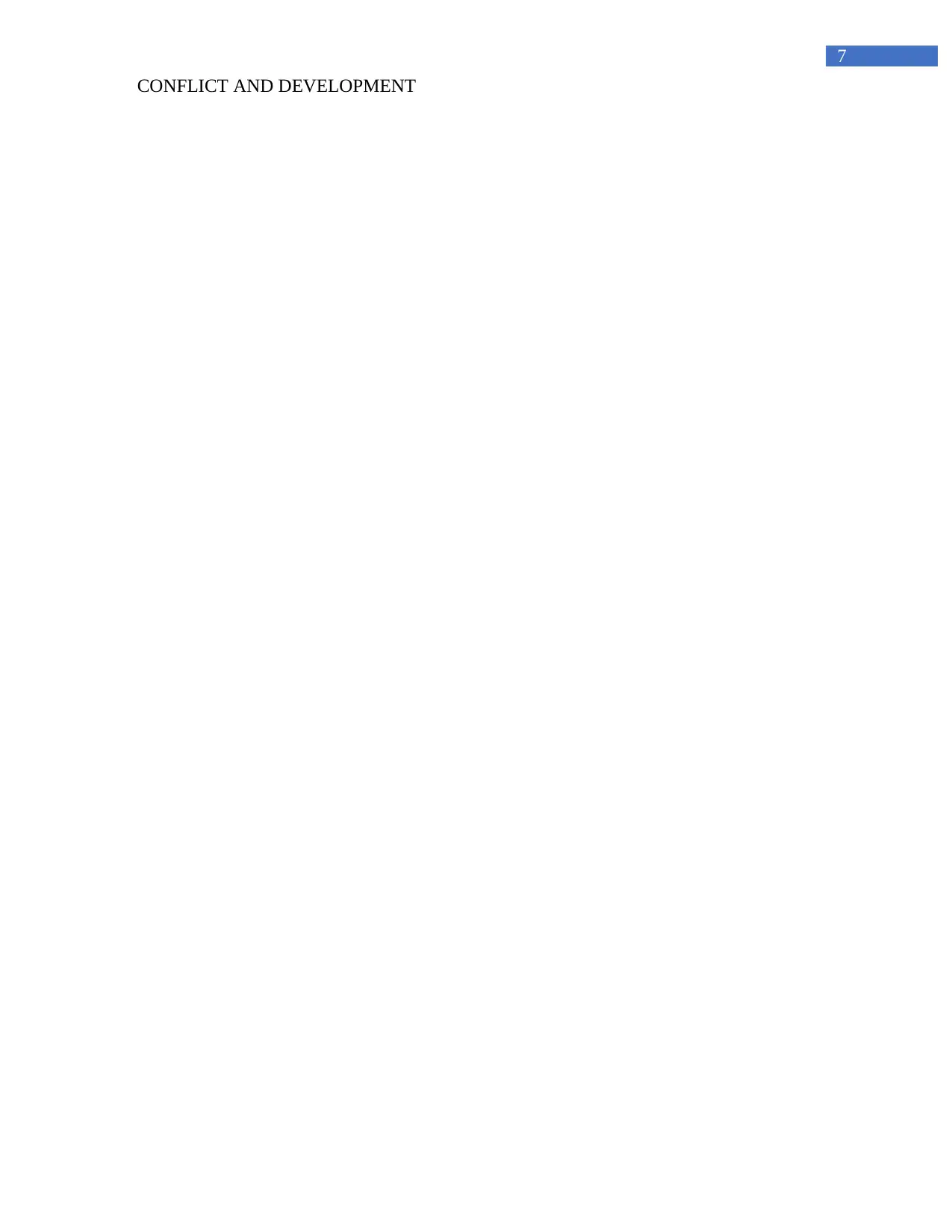
7
CONFLICT AND DEVELOPMENT
CONFLICT AND DEVELOPMENT
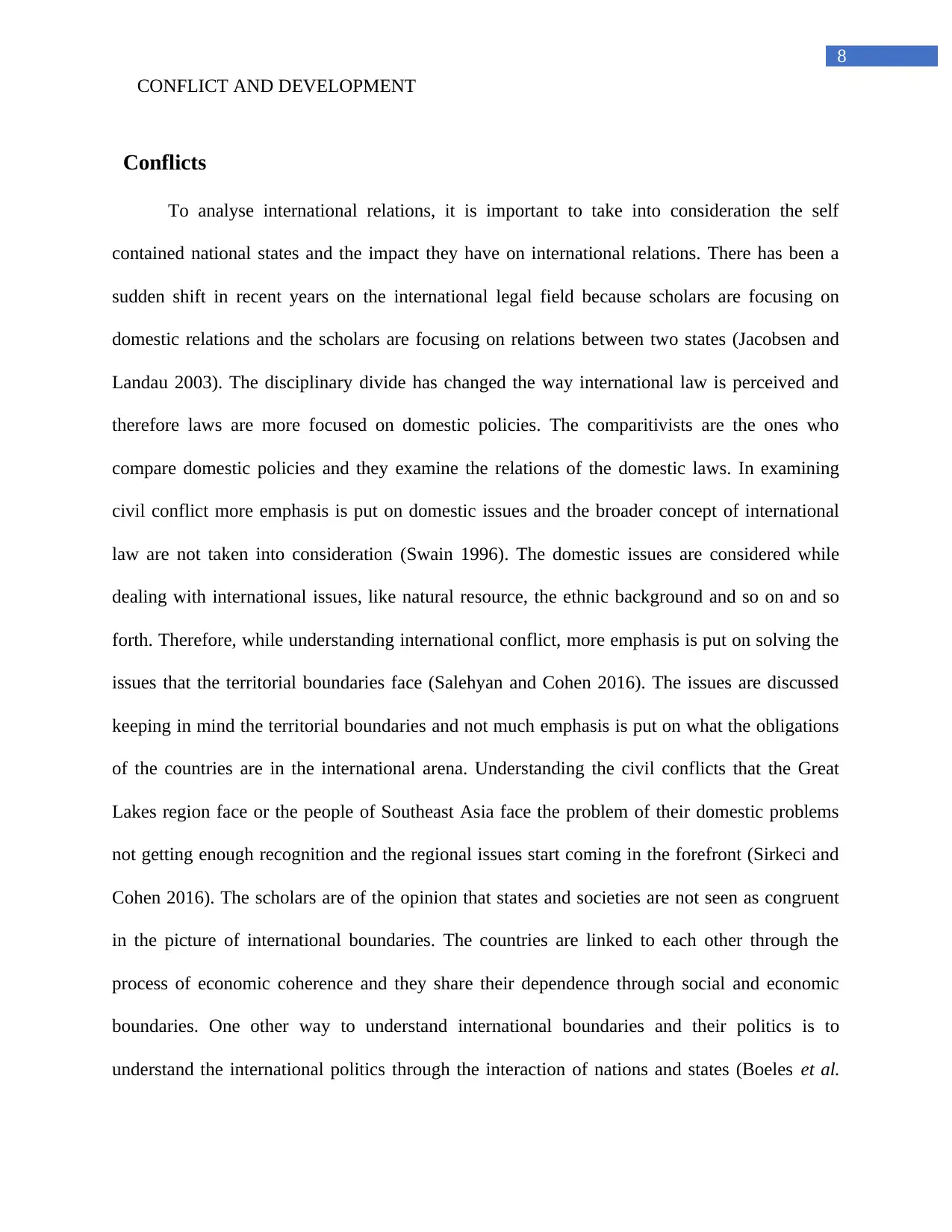
8
CONFLICT AND DEVELOPMENT
Conflicts
To analyse international relations, it is important to take into consideration the self
contained national states and the impact they have on international relations. There has been a
sudden shift in recent years on the international legal field because scholars are focusing on
domestic relations and the scholars are focusing on relations between two states (Jacobsen and
Landau 2003). The disciplinary divide has changed the way international law is perceived and
therefore laws are more focused on domestic policies. The comparitivists are the ones who
compare domestic policies and they examine the relations of the domestic laws. In examining
civil conflict more emphasis is put on domestic issues and the broader concept of international
law are not taken into consideration (Swain 1996). The domestic issues are considered while
dealing with international issues, like natural resource, the ethnic background and so on and so
forth. Therefore, while understanding international conflict, more emphasis is put on solving the
issues that the territorial boundaries face (Salehyan and Cohen 2016). The issues are discussed
keeping in mind the territorial boundaries and not much emphasis is put on what the obligations
of the countries are in the international arena. Understanding the civil conflicts that the Great
Lakes region face or the people of Southeast Asia face the problem of their domestic problems
not getting enough recognition and the regional issues start coming in the forefront (Sirkeci and
Cohen 2016). The scholars are of the opinion that states and societies are not seen as congruent
in the picture of international boundaries. The countries are linked to each other through the
process of economic coherence and they share their dependence through social and economic
boundaries. One other way to understand international boundaries and their politics is to
understand the international politics through the interaction of nations and states (Boeles et al.
CONFLICT AND DEVELOPMENT
Conflicts
To analyse international relations, it is important to take into consideration the self
contained national states and the impact they have on international relations. There has been a
sudden shift in recent years on the international legal field because scholars are focusing on
domestic relations and the scholars are focusing on relations between two states (Jacobsen and
Landau 2003). The disciplinary divide has changed the way international law is perceived and
therefore laws are more focused on domestic policies. The comparitivists are the ones who
compare domestic policies and they examine the relations of the domestic laws. In examining
civil conflict more emphasis is put on domestic issues and the broader concept of international
law are not taken into consideration (Swain 1996). The domestic issues are considered while
dealing with international issues, like natural resource, the ethnic background and so on and so
forth. Therefore, while understanding international conflict, more emphasis is put on solving the
issues that the territorial boundaries face (Salehyan and Cohen 2016). The issues are discussed
keeping in mind the territorial boundaries and not much emphasis is put on what the obligations
of the countries are in the international arena. Understanding the civil conflicts that the Great
Lakes region face or the people of Southeast Asia face the problem of their domestic problems
not getting enough recognition and the regional issues start coming in the forefront (Sirkeci and
Cohen 2016). The scholars are of the opinion that states and societies are not seen as congruent
in the picture of international boundaries. The countries are linked to each other through the
process of economic coherence and they share their dependence through social and economic
boundaries. One other way to understand international boundaries and their politics is to
understand the international politics through the interaction of nations and states (Boeles et al.
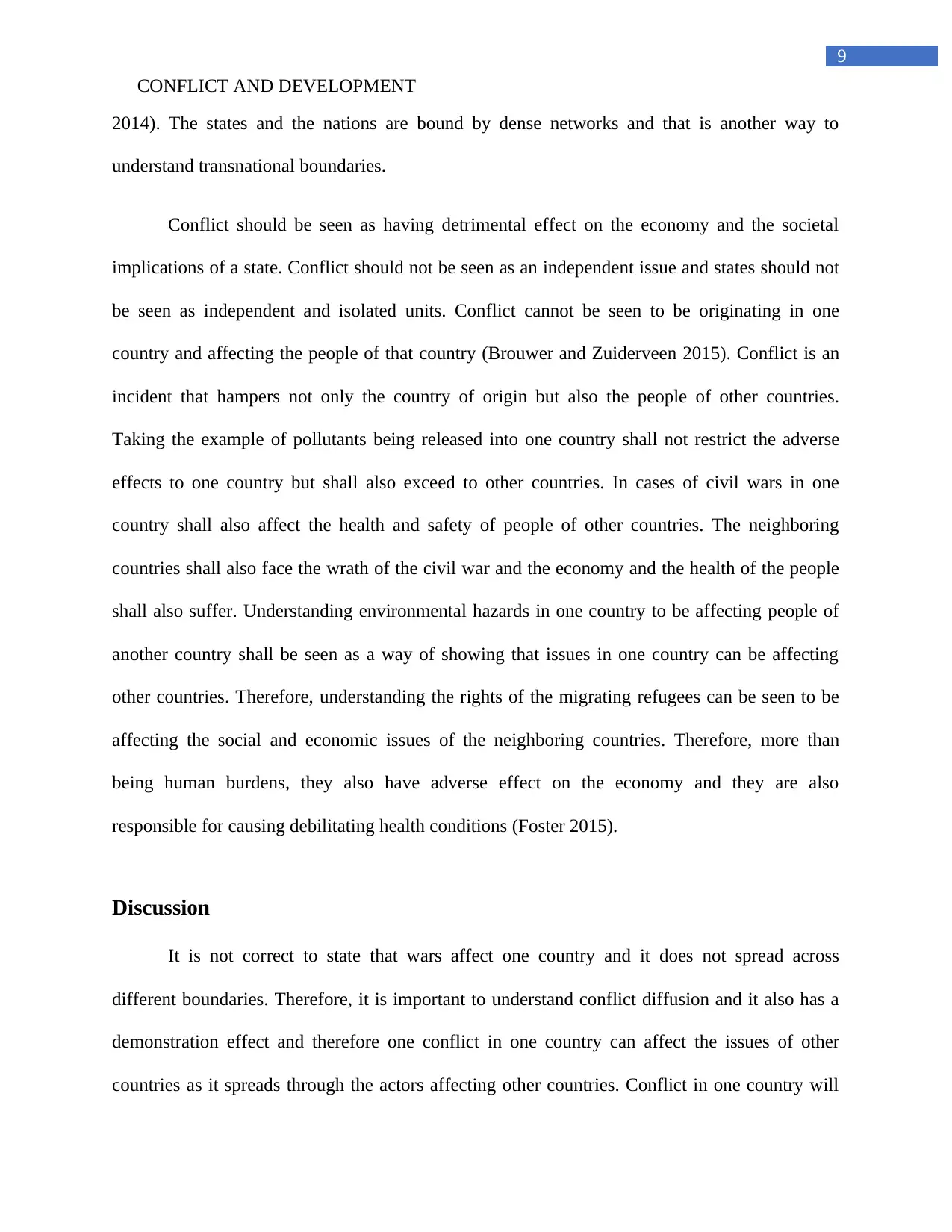
9
CONFLICT AND DEVELOPMENT
2014). The states and the nations are bound by dense networks and that is another way to
understand transnational boundaries.
Conflict should be seen as having detrimental effect on the economy and the societal
implications of a state. Conflict should not be seen as an independent issue and states should not
be seen as independent and isolated units. Conflict cannot be seen to be originating in one
country and affecting the people of that country (Brouwer and Zuiderveen 2015). Conflict is an
incident that hampers not only the country of origin but also the people of other countries.
Taking the example of pollutants being released into one country shall not restrict the adverse
effects to one country but shall also exceed to other countries. In cases of civil wars in one
country shall also affect the health and safety of people of other countries. The neighboring
countries shall also face the wrath of the civil war and the economy and the health of the people
shall also suffer. Understanding environmental hazards in one country to be affecting people of
another country shall be seen as a way of showing that issues in one country can be affecting
other countries. Therefore, understanding the rights of the migrating refugees can be seen to be
affecting the social and economic issues of the neighboring countries. Therefore, more than
being human burdens, they also have adverse effect on the economy and they are also
responsible for causing debilitating health conditions (Foster 2015).
Discussion
It is not correct to state that wars affect one country and it does not spread across
different boundaries. Therefore, it is important to understand conflict diffusion and it also has a
demonstration effect and therefore one conflict in one country can affect the issues of other
countries as it spreads through the actors affecting other countries. Conflict in one country will
CONFLICT AND DEVELOPMENT
2014). The states and the nations are bound by dense networks and that is another way to
understand transnational boundaries.
Conflict should be seen as having detrimental effect on the economy and the societal
implications of a state. Conflict should not be seen as an independent issue and states should not
be seen as independent and isolated units. Conflict cannot be seen to be originating in one
country and affecting the people of that country (Brouwer and Zuiderveen 2015). Conflict is an
incident that hampers not only the country of origin but also the people of other countries.
Taking the example of pollutants being released into one country shall not restrict the adverse
effects to one country but shall also exceed to other countries. In cases of civil wars in one
country shall also affect the health and safety of people of other countries. The neighboring
countries shall also face the wrath of the civil war and the economy and the health of the people
shall also suffer. Understanding environmental hazards in one country to be affecting people of
another country shall be seen as a way of showing that issues in one country can be affecting
other countries. Therefore, understanding the rights of the migrating refugees can be seen to be
affecting the social and economic issues of the neighboring countries. Therefore, more than
being human burdens, they also have adverse effect on the economy and they are also
responsible for causing debilitating health conditions (Foster 2015).
Discussion
It is not correct to state that wars affect one country and it does not spread across
different boundaries. Therefore, it is important to understand conflict diffusion and it also has a
demonstration effect and therefore one conflict in one country can affect the issues of other
countries as it spreads through the actors affecting other countries. Conflict in one country will
Secure Best Marks with AI Grader
Need help grading? Try our AI Grader for instant feedback on your assignments.
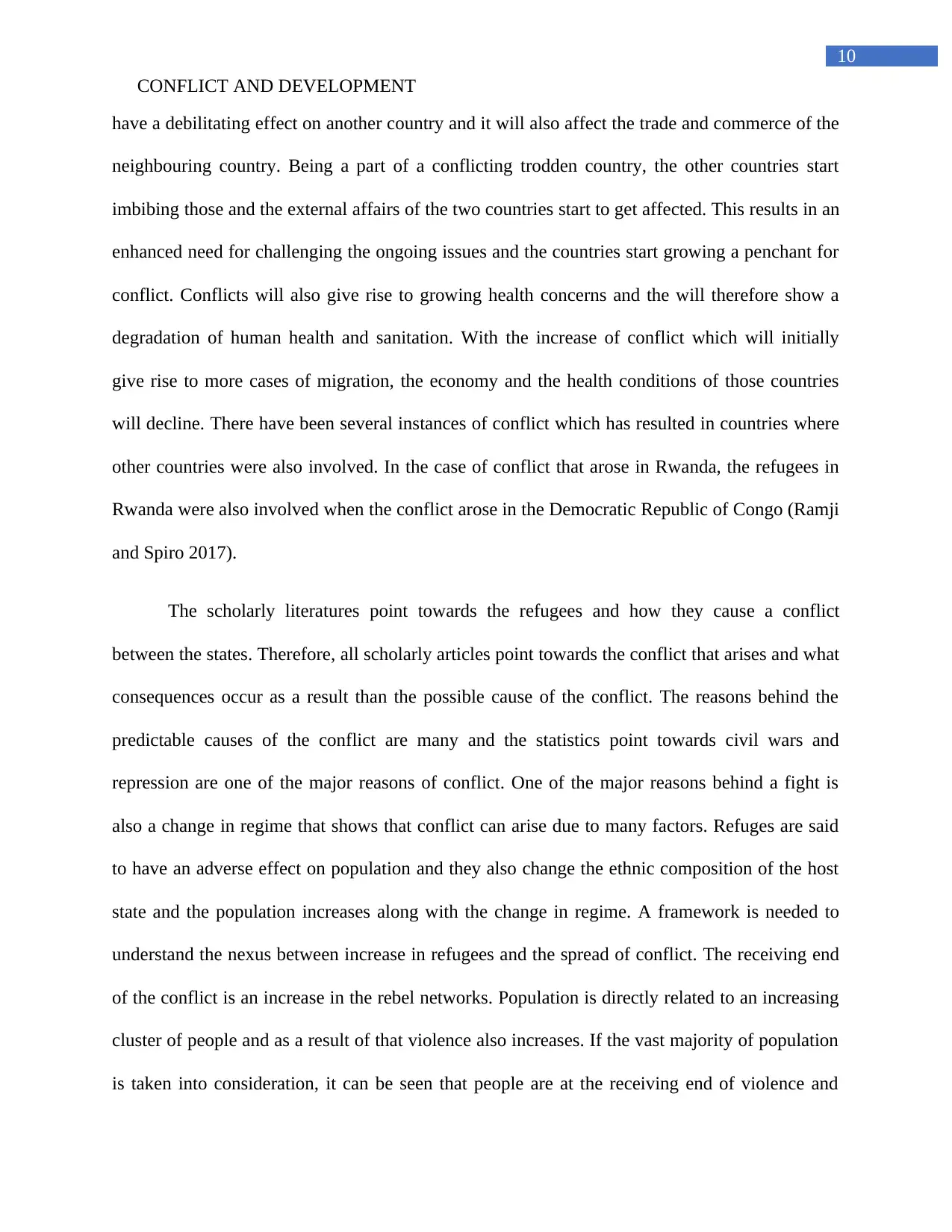
10
CONFLICT AND DEVELOPMENT
have a debilitating effect on another country and it will also affect the trade and commerce of the
neighbouring country. Being a part of a conflicting trodden country, the other countries start
imbibing those and the external affairs of the two countries start to get affected. This results in an
enhanced need for challenging the ongoing issues and the countries start growing a penchant for
conflict. Conflicts will also give rise to growing health concerns and the will therefore show a
degradation of human health and sanitation. With the increase of conflict which will initially
give rise to more cases of migration, the economy and the health conditions of those countries
will decline. There have been several instances of conflict which has resulted in countries where
other countries were also involved. In the case of conflict that arose in Rwanda, the refugees in
Rwanda were also involved when the conflict arose in the Democratic Republic of Congo (Ramji
and Spiro 2017).
The scholarly literatures point towards the refugees and how they cause a conflict
between the states. Therefore, all scholarly articles point towards the conflict that arises and what
consequences occur as a result than the possible cause of the conflict. The reasons behind the
predictable causes of the conflict are many and the statistics point towards civil wars and
repression are one of the major reasons of conflict. One of the major reasons behind a fight is
also a change in regime that shows that conflict can arise due to many factors. Refuges are said
to have an adverse effect on population and they also change the ethnic composition of the host
state and the population increases along with the change in regime. A framework is needed to
understand the nexus between increase in refugees and the spread of conflict. The receiving end
of the conflict is an increase in the rebel networks. Population is directly related to an increasing
cluster of people and as a result of that violence also increases. If the vast majority of population
is taken into consideration, it can be seen that people are at the receiving end of violence and
CONFLICT AND DEVELOPMENT
have a debilitating effect on another country and it will also affect the trade and commerce of the
neighbouring country. Being a part of a conflicting trodden country, the other countries start
imbibing those and the external affairs of the two countries start to get affected. This results in an
enhanced need for challenging the ongoing issues and the countries start growing a penchant for
conflict. Conflicts will also give rise to growing health concerns and the will therefore show a
degradation of human health and sanitation. With the increase of conflict which will initially
give rise to more cases of migration, the economy and the health conditions of those countries
will decline. There have been several instances of conflict which has resulted in countries where
other countries were also involved. In the case of conflict that arose in Rwanda, the refugees in
Rwanda were also involved when the conflict arose in the Democratic Republic of Congo (Ramji
and Spiro 2017).
The scholarly literatures point towards the refugees and how they cause a conflict
between the states. Therefore, all scholarly articles point towards the conflict that arises and what
consequences occur as a result than the possible cause of the conflict. The reasons behind the
predictable causes of the conflict are many and the statistics point towards civil wars and
repression are one of the major reasons of conflict. One of the major reasons behind a fight is
also a change in regime that shows that conflict can arise due to many factors. Refuges are said
to have an adverse effect on population and they also change the ethnic composition of the host
state and the population increases along with the change in regime. A framework is needed to
understand the nexus between increase in refugees and the spread of conflict. The receiving end
of the conflict is an increase in the rebel networks. Population is directly related to an increasing
cluster of people and as a result of that violence also increases. If the vast majority of population
is taken into consideration, it can be seen that people are at the receiving end of violence and
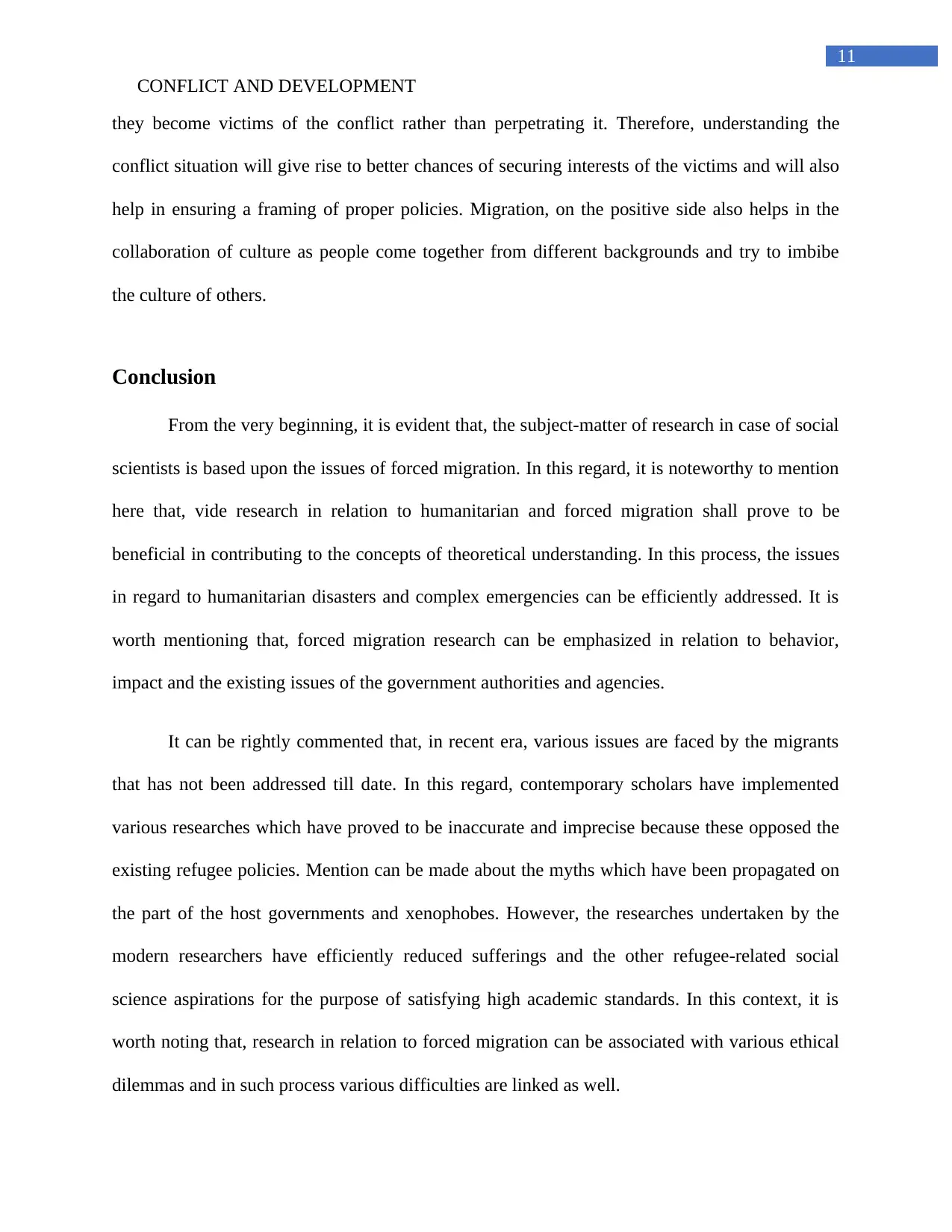
11
CONFLICT AND DEVELOPMENT
they become victims of the conflict rather than perpetrating it. Therefore, understanding the
conflict situation will give rise to better chances of securing interests of the victims and will also
help in ensuring a framing of proper policies. Migration, on the positive side also helps in the
collaboration of culture as people come together from different backgrounds and try to imbibe
the culture of others.
Conclusion
From the very beginning, it is evident that, the subject-matter of research in case of social
scientists is based upon the issues of forced migration. In this regard, it is noteworthy to mention
here that, vide research in relation to humanitarian and forced migration shall prove to be
beneficial in contributing to the concepts of theoretical understanding. In this process, the issues
in regard to humanitarian disasters and complex emergencies can be efficiently addressed. It is
worth mentioning that, forced migration research can be emphasized in relation to behavior,
impact and the existing issues of the government authorities and agencies.
It can be rightly commented that, in recent era, various issues are faced by the migrants
that has not been addressed till date. In this regard, contemporary scholars have implemented
various researches which have proved to be inaccurate and imprecise because these opposed the
existing refugee policies. Mention can be made about the myths which have been propagated on
the part of the host governments and xenophobes. However, the researches undertaken by the
modern researchers have efficiently reduced sufferings and the other refugee-related social
science aspirations for the purpose of satisfying high academic standards. In this context, it is
worth noting that, research in relation to forced migration can be associated with various ethical
dilemmas and in such process various difficulties are linked as well.
CONFLICT AND DEVELOPMENT
they become victims of the conflict rather than perpetrating it. Therefore, understanding the
conflict situation will give rise to better chances of securing interests of the victims and will also
help in ensuring a framing of proper policies. Migration, on the positive side also helps in the
collaboration of culture as people come together from different backgrounds and try to imbibe
the culture of others.
Conclusion
From the very beginning, it is evident that, the subject-matter of research in case of social
scientists is based upon the issues of forced migration. In this regard, it is noteworthy to mention
here that, vide research in relation to humanitarian and forced migration shall prove to be
beneficial in contributing to the concepts of theoretical understanding. In this process, the issues
in regard to humanitarian disasters and complex emergencies can be efficiently addressed. It is
worth mentioning that, forced migration research can be emphasized in relation to behavior,
impact and the existing issues of the government authorities and agencies.
It can be rightly commented that, in recent era, various issues are faced by the migrants
that has not been addressed till date. In this regard, contemporary scholars have implemented
various researches which have proved to be inaccurate and imprecise because these opposed the
existing refugee policies. Mention can be made about the myths which have been propagated on
the part of the host governments and xenophobes. However, the researches undertaken by the
modern researchers have efficiently reduced sufferings and the other refugee-related social
science aspirations for the purpose of satisfying high academic standards. In this context, it is
worth noting that, research in relation to forced migration can be associated with various ethical
dilemmas and in such process various difficulties are linked as well.
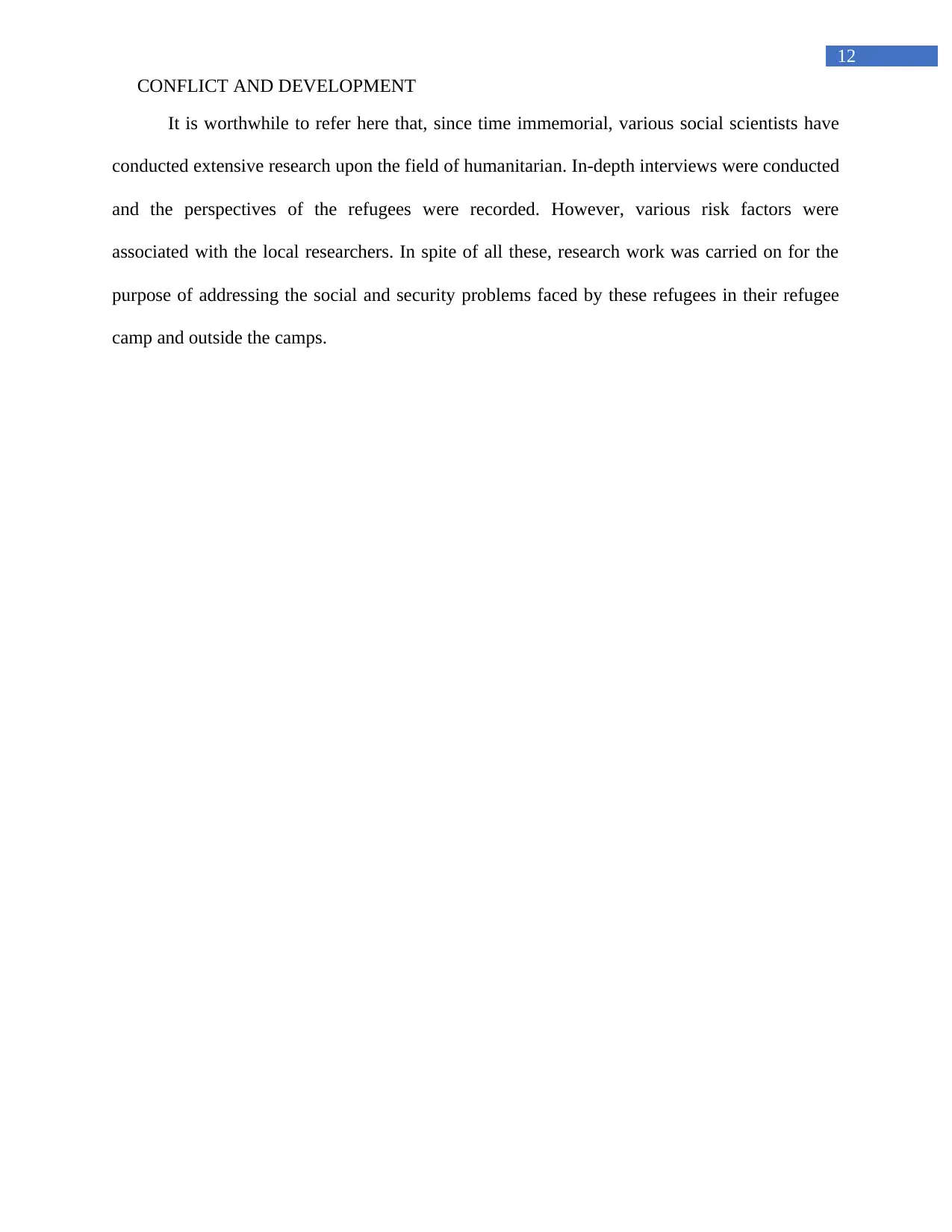
12
CONFLICT AND DEVELOPMENT
It is worthwhile to refer here that, since time immemorial, various social scientists have
conducted extensive research upon the field of humanitarian. In-depth interviews were conducted
and the perspectives of the refugees were recorded. However, various risk factors were
associated with the local researchers. In spite of all these, research work was carried on for the
purpose of addressing the social and security problems faced by these refugees in their refugee
camp and outside the camps.
CONFLICT AND DEVELOPMENT
It is worthwhile to refer here that, since time immemorial, various social scientists have
conducted extensive research upon the field of humanitarian. In-depth interviews were conducted
and the perspectives of the refugees were recorded. However, various risk factors were
associated with the local researchers. In spite of all these, research work was carried on for the
purpose of addressing the social and security problems faced by these refugees in their refugee
camp and outside the camps.
Paraphrase This Document
Need a fresh take? Get an instant paraphrase of this document with our AI Paraphraser
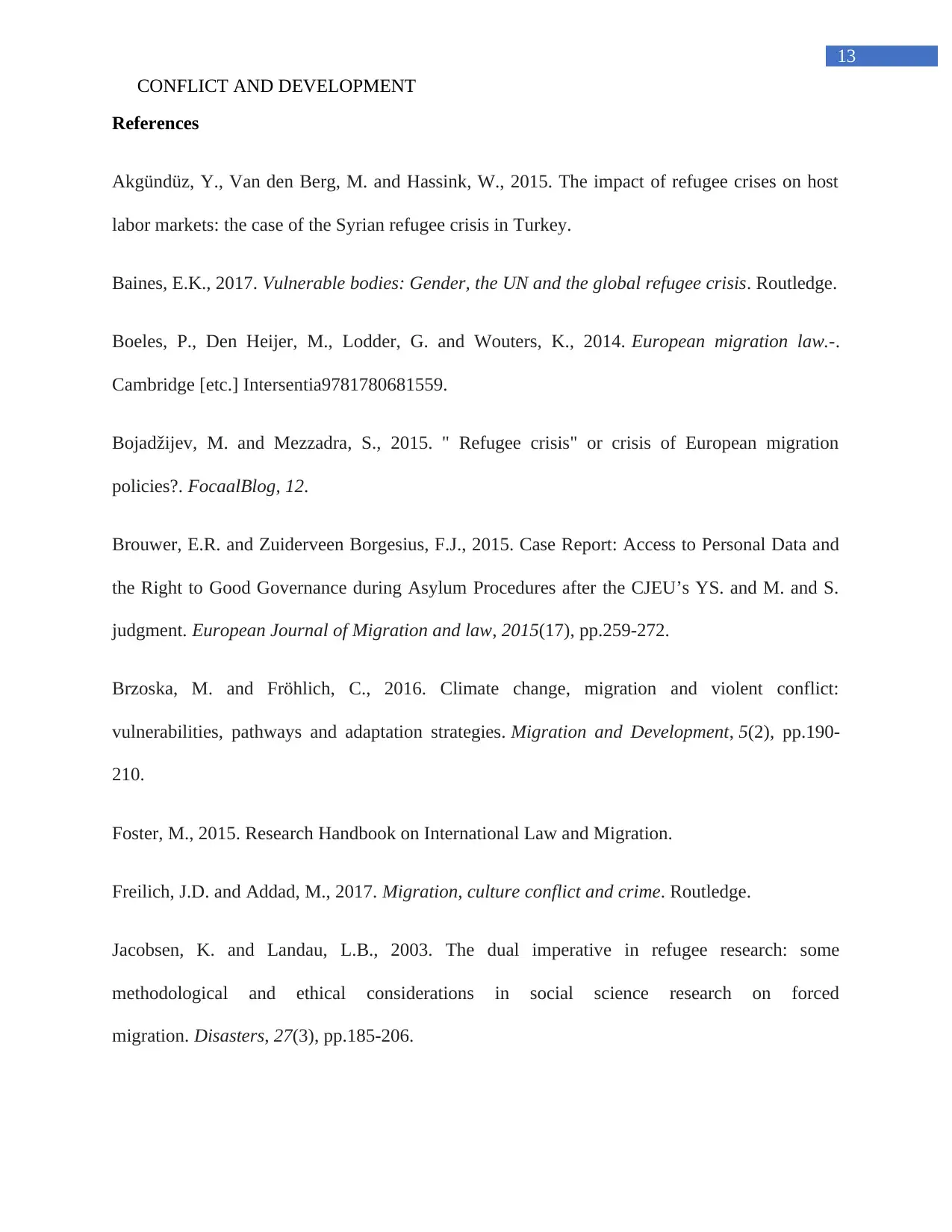
13
CONFLICT AND DEVELOPMENT
References
Akgündüz, Y., Van den Berg, M. and Hassink, W., 2015. The impact of refugee crises on host
labor markets: the case of the Syrian refugee crisis in Turkey.
Baines, E.K., 2017. Vulnerable bodies: Gender, the UN and the global refugee crisis. Routledge.
Boeles, P., Den Heijer, M., Lodder, G. and Wouters, K., 2014. European migration law.-.
Cambridge [etc.] Intersentia9781780681559.
Bojadžijev, M. and Mezzadra, S., 2015. " Refugee crisis" or crisis of European migration
policies?. FocaalBlog, 12.
Brouwer, E.R. and Zuiderveen Borgesius, F.J., 2015. Case Report: Access to Personal Data and
the Right to Good Governance during Asylum Procedures after the CJEU’s YS. and M. and S.
judgment. European Journal of Migration and law, 2015(17), pp.259-272.
Brzoska, M. and Fröhlich, C., 2016. Climate change, migration and violent conflict:
vulnerabilities, pathways and adaptation strategies. Migration and Development, 5(2), pp.190-
210.
Foster, M., 2015. Research Handbook on International Law and Migration.
Freilich, J.D. and Addad, M., 2017. Migration, culture conflict and crime. Routledge.
Jacobsen, K. and Landau, L.B., 2003. The dual imperative in refugee research: some
methodological and ethical considerations in social science research on forced
migration. Disasters, 27(3), pp.185-206.
CONFLICT AND DEVELOPMENT
References
Akgündüz, Y., Van den Berg, M. and Hassink, W., 2015. The impact of refugee crises on host
labor markets: the case of the Syrian refugee crisis in Turkey.
Baines, E.K., 2017. Vulnerable bodies: Gender, the UN and the global refugee crisis. Routledge.
Boeles, P., Den Heijer, M., Lodder, G. and Wouters, K., 2014. European migration law.-.
Cambridge [etc.] Intersentia9781780681559.
Bojadžijev, M. and Mezzadra, S., 2015. " Refugee crisis" or crisis of European migration
policies?. FocaalBlog, 12.
Brouwer, E.R. and Zuiderveen Borgesius, F.J., 2015. Case Report: Access to Personal Data and
the Right to Good Governance during Asylum Procedures after the CJEU’s YS. and M. and S.
judgment. European Journal of Migration and law, 2015(17), pp.259-272.
Brzoska, M. and Fröhlich, C., 2016. Climate change, migration and violent conflict:
vulnerabilities, pathways and adaptation strategies. Migration and Development, 5(2), pp.190-
210.
Foster, M., 2015. Research Handbook on International Law and Migration.
Freilich, J.D. and Addad, M., 2017. Migration, culture conflict and crime. Routledge.
Jacobsen, K. and Landau, L.B., 2003. The dual imperative in refugee research: some
methodological and ethical considerations in social science research on forced
migration. Disasters, 27(3), pp.185-206.
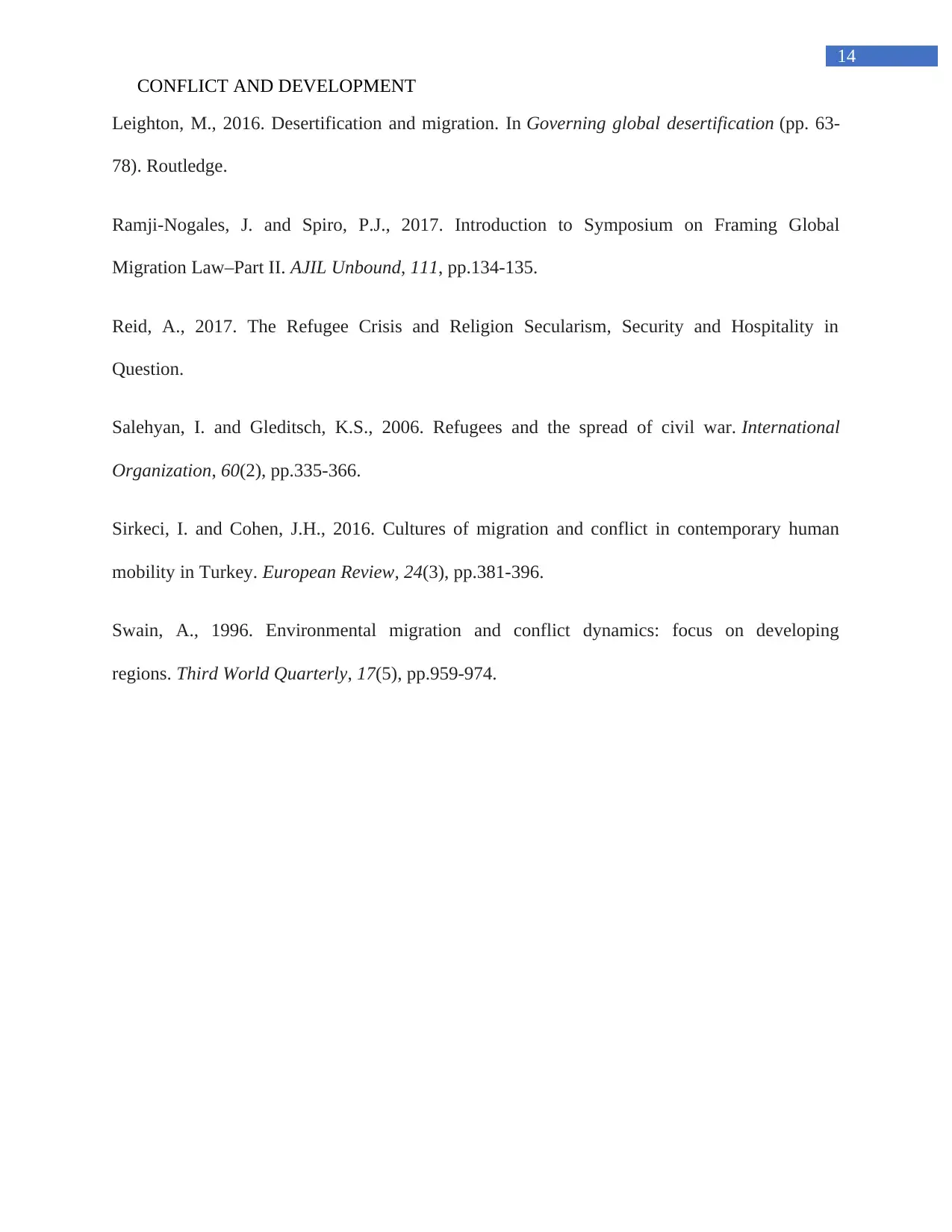
14
CONFLICT AND DEVELOPMENT
Leighton, M., 2016. Desertification and migration. In Governing global desertification (pp. 63-
78). Routledge.
Ramji-Nogales, J. and Spiro, P.J., 2017. Introduction to Symposium on Framing Global
Migration Law–Part II. AJIL Unbound, 111, pp.134-135.
Reid, A., 2017. The Refugee Crisis and Religion Secularism, Security and Hospitality in
Question.
Salehyan, I. and Gleditsch, K.S., 2006. Refugees and the spread of civil war. International
Organization, 60(2), pp.335-366.
Sirkeci, I. and Cohen, J.H., 2016. Cultures of migration and conflict in contemporary human
mobility in Turkey. European Review, 24(3), pp.381-396.
Swain, A., 1996. Environmental migration and conflict dynamics: focus on developing
regions. Third World Quarterly, 17(5), pp.959-974.
CONFLICT AND DEVELOPMENT
Leighton, M., 2016. Desertification and migration. In Governing global desertification (pp. 63-
78). Routledge.
Ramji-Nogales, J. and Spiro, P.J., 2017. Introduction to Symposium on Framing Global
Migration Law–Part II. AJIL Unbound, 111, pp.134-135.
Reid, A., 2017. The Refugee Crisis and Religion Secularism, Security and Hospitality in
Question.
Salehyan, I. and Gleditsch, K.S., 2006. Refugees and the spread of civil war. International
Organization, 60(2), pp.335-366.
Sirkeci, I. and Cohen, J.H., 2016. Cultures of migration and conflict in contemporary human
mobility in Turkey. European Review, 24(3), pp.381-396.
Swain, A., 1996. Environmental migration and conflict dynamics: focus on developing
regions. Third World Quarterly, 17(5), pp.959-974.
1 out of 15
Your All-in-One AI-Powered Toolkit for Academic Success.
+13062052269
info@desklib.com
Available 24*7 on WhatsApp / Email
![[object Object]](/_next/static/media/star-bottom.7253800d.svg)
Unlock your academic potential
© 2024 | Zucol Services PVT LTD | All rights reserved.